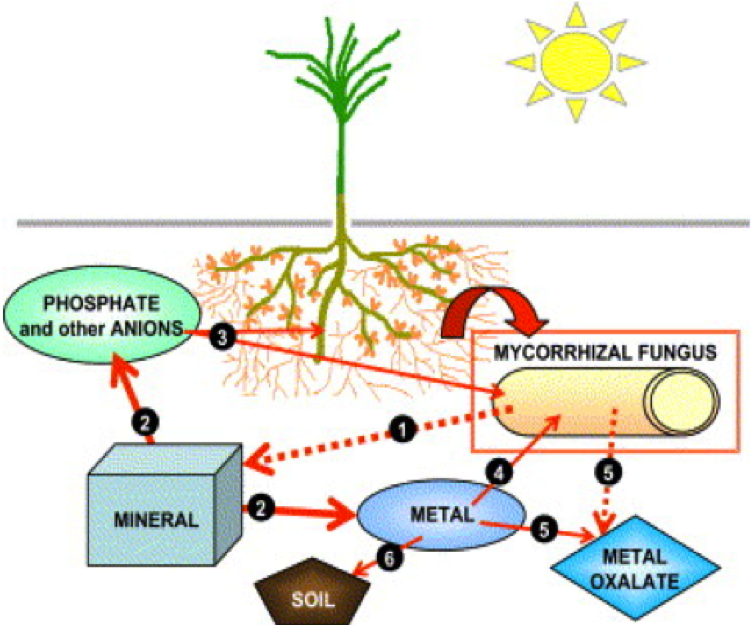Project 1: Alteration and Remediation of Asbestos Fibers
Significance
Current state-of-the-art for treatment of asbestos-contaminated sites is to move the asbestos and/or cap the site. The proposed research examines whether chemical alteration of asbestos particles by plants and/or fungi, either directly or indirectly via plant exudates or fungal metabolites, may be useful for bioremediation of asbestos-contaminated sites.

Project 1 is motivated by evidence that fungi (Fusarium oxysporum and Verticillium leptobactrum) can remove Fe atoms from asbestos particles, rendering them less toxic. We will target plant species that are known to be metal hyper-accumulators or are native to soils naturally high in heavy metals, such as serpentine soils, and whose roots form mutualist relationships with arbuscular mycorrhizal fungi (AMF) (from Fomina et al. 2006)
Hypothesis
We hypothesize that it is possible to discover and quantify new ways to remediate asbestos sites in situ using a combination of hyper-accumulating plants and plants native to serpentine soils coupled with their associated arbuscular mycorrhizal fungi (AMF).
The hypothesis will be tested using three specific strategies:
- Determine new ways to remediate asbestos piles using iron hyper-accumulating plants, plants native to serpentine soils with AMF associations, and the exudates and metabolites fundamentally responsible for the chemical and physical alteration,
- Validate the effect, rate and chemical mechanisms of asbestos fiber remediation by chemical analysis and spectroscopy techniques and to produce remediated fibers in suspension to apply to cells in Project 4, and to test directly, in animal model systems, whether remediation of asbestos abrogates its carcinogenic potential in vivo in Project 5, and to determine the size reduction and surface charge change of remediated fibers, which applies to Project 2, and
- Determine whether soil microbial constituents at the Ambler Superfund site and the relative abundance of different AMF species in greenhouse treatments respond to the presence of asbestos, providing clues to effective agents for bioremediation.
Highly controlled greenhouse experiments coupled with Scanning Transmission Electron Microscopy, X-ray Diffraction characterization and Inductively Coupled Plasma Optical Emission Spectrometry will document the efficacy of different plant species and combinations of mycorrhizal fungal species in removing Fe from asbestos and destroying the fibrous structure. Where asbestos is altered at the greatest rates, high throughput DNA sequencing and pyrosequencing will be used to quantity the relative abundance of the different AMF species.
We believe that the proposed research will produce new remediation strategies for asbestos at Superfund and Brownfields sites, and will eventually lead to marketing such a technique for other sites of asbestos contamination. Our results have direct impact on Project 2 and we will communicate how our asbestos remediation affects asbestos fiber size, transport and aggregate formation.
We will work closely to confirm reduced toxicity of remediated fibers with the animal model studies in Project 4, and we will be to take advantage of the in vitro asbestos-induced cell injury models developed in Project 5 to compare the activity of untreated and remediated asbestos fibers. Project 1 will interact with the Community Engagement Core to ensure that as the knowledge of the science of remediation evolves this will be disseminated to the residents of Ambler via presentations to the Community Action Group (CAG) and Stakeholder Advisory Group.
Postdoctoral researchers leading Project 1 will be a part of the Interdisciplinary Training Core, and so will contribute to the diversity of scientific expertise while taking part in research and seminars that promote cross-disciplinary interactions. The Project will work closely with the Research Translation Core in that our results will be used to produce a feasibility document to expand the remediation technique for use at Superfund and Brownfields sites. Biostatistical expertise will be provided by the Biostatistics Research Support Core. Financial oversight and general project administration will require the expertise of the Administrative Core.
Project Leader(s)
Brenda Casper, PhD, Project Leader
Professor and Chair, Department of Biology, School of Arts and Sciences, University of Pennsylvania
bcasper@sas.upenn.edu
Publications
Click Here to view all publications

